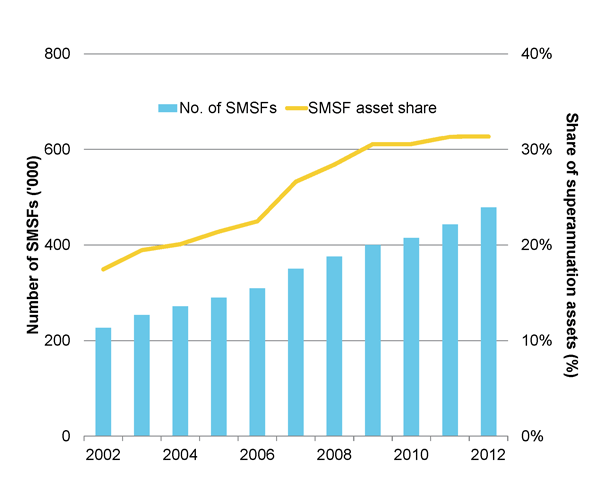Kai Swoboda, Economics
Key issue
‘DIY super’, formalised through the self-managed superannuation fund (SMSF) regulatory framework, is an important and growing part of the superannuation system. With the SMSF sector largely seen to operate effectively, any further intervention needs to carefully consider the impact of additional regulation on SMSFs and the superannuation industry as a whole. |
Self-managed Superannuation Funds (SMSFs)—funds with one to four members where the members also actively participate in the management of the fund—are an important and growing part of the superannuation sector. The availability of the option to establish an SMSF provides for greater choice and flexibility for superannuation fund members and also creates some competitive pressures within the superannuation industry as a whole.
Over the last decade, the number of SMSFs has increased by an average of 7.7% per year, rising from around 227,000 in June 2002, to around 478,000 by June 2012. Over the same period, the value of superannuation assets held in SMSFs increased from $90 billion to $439 billion. By June 2012 the SMSF sector accounted for around 31% of total superannuation assets (Figure 1). Superannuation industry analysts generally agree that the SMSF sector will continue to grow at similar rates.
Figure 1: SMSF growth, 2002 to 2012
Source: Australian Prudential Regulation Authority.
Choosing an SMSF
The main reason people choose to establish an SMSF is to gain control of their retirement savings. Many people believe that they can make sound investment decisions which will outperform those made by an institutional superannuation fund. In addition, establishing an SMSF can save on fees. There are typically three groups of SMSF trustees. Around 30% of SMSF trustees are ‘controllers’ (those who manage their money themselves), 50% are ‘coach seekers’ (those who need information to make their decisions) and the remaining 20% are ‘outsourcers’ (those who hire people to manage their funds).
Compared to those in institutional superannuation funds, members of SMSFs:
- tend to be older. (In coming years this difference may decline as younger people are increasingly attracted to establishing an SMSF)
- have significantly higher balances. (While this is a reflection of the older population group that is a feature of SMSFs, it is also an indicator that the benefits of establishing an SMSF may not outweigh the costs for those with lower account balances)
- are more conservative in asset allocation, with a higher proportion of cash and term deposits and a lower proportion of international shares—this may also be related to the older population group favouring capital security rather than higher (though potentially risky) returns as they approach retirement.
Regulating SMSFs
SMSFs and institutional funds share the same primary objective—providing benefits on or after the member’s retirement, on reaching age 65, or on earlier death. However, a key difference is in the regulatory approach. Institutional funds are subject to a regulatory framework overseen by the Australian Prudential Regulation Authority that emphasises risk management and stability. SMSFs are largely regulated on a compliance basis by the Australian Taxation Office.
In addition to this difference in regulatory approach, some SMSF-specific arrangements are also in place. These additional arrangements support the primary objective of providing for retirement benefits. For example, there are additional rules for SMSFs relating to prohibiting the acquisition of certain assets from related parties.
During the 43rd Parliament, a number of SMSF-specific regulatory arrangements were implemented, including an SMSF auditor registration scheme and limits on investing in collectables and personal use assets. Several others, including a penalty regime for those involved in schemes to access superannuation early and creating an administrative penalty regime for SMSF trustees, were introduced into the Parliament but have lapsed. Some of these may be further considered by the 44th Parliament.
SMSF sector performance and potential regulatory issues
It is difficult to make direct comparisons between the performance of SMSFs and institutional funds. Where data are available, average annual SMSF returns have been similar to institutional funds over recent years. In general, SMSFs with larger balances have performed better than SMSFs with lower balances.
Despite this solid performance relative to institutional funds, there remain a number of concerns about SMSFs, including how funds are established and managed, the appropriateness of certain investments and the capacity of trustees.
The Cooper Review of superannuation (May 2009–June 2010) considered that the SMSF sector was ‘largely successful and well-functioning’. Nevertheless, policy interventions that have continued to be discussed or emerged since the Cooper Review include:
- whether a mandatory minimum account balance should be imposed
- the need for an SMSF compensation scheme funded by an SMSF levy to protect against losses
- improving the proficiency of trustees and the capacity of trustees to manage their SMSF as they age or a trustee dies
- the role that service providers such as accountants and financial advisers play in assisting trustees to manage their SMSF.
Balancing the need for further SMSF regulation with the choice to use an SMSF
The decision to establish an SMSF rather than utilise the protections provided in a prudentially-regulated institutional superannuation fund is one that individuals are free to make.
Any further intervention by government needs to balance carefully the relative costs and benefits from additional regulation as well as the superannuation system-wide benefits that are available with an active and successful SMSF sector.
Further reading
K Swoboda, Superannuation Legislation Amendment (Reducing Illegal Early Release and Other Measures) Bill 2012, Bills digest, 65, 2012–13, 5 February 2013.
J Castillo, ‘The SMSF trustee-members’, Australian Business Law Review, 6(3), June 2012.
Review into the Governance, Efficiency, Structure and Operation of Australia’s Superannuation System, Self managed super solutions: phase three preliminary report, (Cooper Review), Commonwealth of Australia, Canberra, 2010.
For copyright reasons some linked items are only available to members of Parliament.
© Commonwealth of Australia